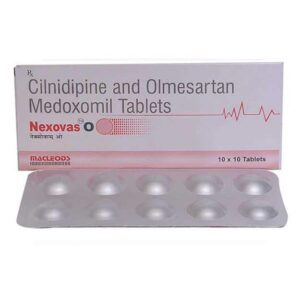OLMESARTAN + CILNIDIPINE
Olmesartan: Olmesartan, sold under the brand name Benicar, is a medication primarily used for the treatment of high blood pressure (hypertension). It belongs to a class of drugs known as angiotensin receptor blockers (ARBs).
The primary mechanism of action of olmesartan is to block the action of angiotensin II, a hormone that causes blood vessels to constrict, resulting in increased blood pressure. By inhibiting the angiotensin II type 1 receptor, olmesartan helps relax and widen the blood vessels, reducing blood pressure.
The usual starting dose of olmesartan for hypertension treatment is 20 mg once daily. However, the dosage may vary based on individual patient response, and it can be increased to a maximum dose of 40 mg per day. It may be taken with or without food.
Common side effects of olmesartan include dizziness, headache, diarrhea, back pain, and flu-like symptoms. It is important to note that some individuals may experience more serious side effects such as allergic reactions, kidney problems, liver dysfunction, or low blood pressure. If any severe side effects occur, medical attention should be sought immediately.
Olmesartan is generally well-tolerated, and most people experience few side effects. It is important to take the medication as prescribed and to consult with a healthcare professional if any concerns or questions arise.
Cilnidipine: Cilnidipine is a medication belonging to the class of dihydropyridine calcium channel blockers. It is primarily used to treat hypertension or high blood pressure.
The mechanism of action of Cilnidipine involves blocking the entry of calcium ions into smooth muscle cells in the walls of blood vessels. By doing so, it relaxes and dilates the blood vessels, leading to a decrease in blood pressure. Additionally, Cilnidipine is considered to be a dual-channel blocker, as it also blocks the N-type calcium channels in the brain, which can help reduce sympathetic outflow, further lowering blood pressure.
The typical starting dose of Cilnidipine is 5 mg once daily, which can be adjusted based on individual response. The maximum recommended dose is 20 mg per day. It is important to follow the dosage instructions provided by your healthcare professional.
Common side effects of Cilnidipine include peripheral edema (swelling in the legs or ankles), headache, dizziness, flushing, and palpitations. These side effects are usually mild and temporary. However, if you experience severe or persistent side effects, it is advisable to consult your doctor.
Cilnidipine may also interact with other medications, so inform your healthcare professional about all the medicines you are currently taking to avoid potential drug interactions.
In summary, Cilnidipine is a calcium channel blocker used for the treatment of hypertension. It relaxes and dilates blood vessels to lower blood pressure. The usual starting dose is 5 mg per day, and common side effects include peripheral edema, headache, and dizziness. Remember to consult your healthcare professional for personalized advice and to discuss any potential side effects or interactions.

